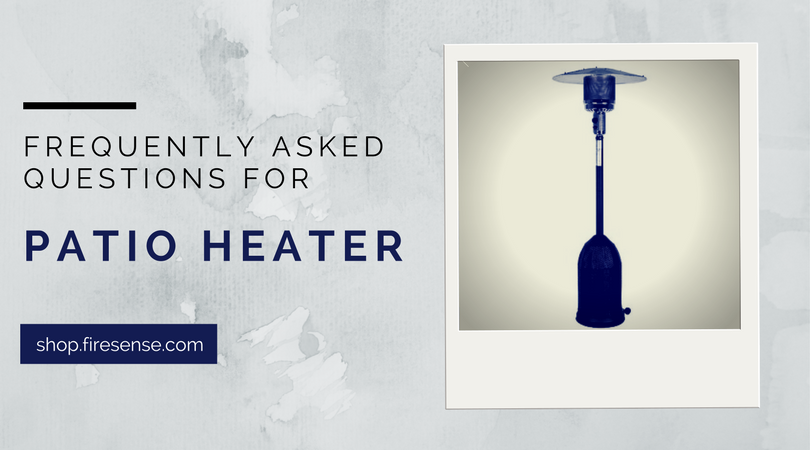Test2

Q: What size propane tank do I need for my patio heater?
Most full size patio heaters use a standard 20 pound propane tank. These are the same type of tanks that are commonly used with BBQ grills.
Q: Does the propane tank come with my patio heater?
Propane tanks do not come with the patio heater and must be purchased separately.
Q: Where do I purchase a propane tank?
Twenty pound propane tanks are easily found at many home improvement, grocery, and convenience stores. Additionally, there are propane tank exchange services where the customer can simply exchange an empty tank for a full one.
Q: How much clearance is required above my patio heater?
Patio heaters must have clearance on all sides. It is recommended that there be three feet above the unit and two feet on each side of the unit.
Q: Can I use my patio heater indoors?
Propane and natural gas patio heaters are for outdoor use only. Our electric patio heaters may be used indoors provided adequate clearance is provided between the heater and flammable materials and people or animals.
Q: Can I shorten the post on my patio heater so the unit is not so tall?
Never shorten the center post on the patio heater. Patio heaters are only to be used at their original height, without modification. We offer tabletop and telescoping electric models if a specific height is desired.
Q: There is a piece of foam inside the bottom of the burner assembly around the hose? Should I remove this?
Some patio heaters come with a piece of foam inside the bottom of the burner assembly around the hose. This foam should be removed before assembling the head unit to the top of the center post. The foam is in place to keep the gas hose from being cut during shipping.
Q: Can my propane patio heater be converted to natural gas?
Our propane patio heaters are manufactured and safety certified for LPG only and we do not recommend altering them in any way. To do so could cause irreparable damage to the unit. If your home has a natural gas hook up then you should consider a natural gas patio heater.
Q: What is a Piezo igniter?
Many patio heaters come with what is called a Piezo igniter. A Piezo igniter is a hammer/quartz crystal mechanism. The igniter button is pressed which causes the hammer to strike the quartz crystal, creating a spark that ignites the propane.
Q: Can my patio heater be used on a wooden deck?
Patio heaters can be used on wooden decks provided that they are never left unattended. Like any fire, a responsible adult must be present at all times during use.
Q: What is covered under warranty?
There is a warranty provided with each heater. This warranty is typically a one year warranty from the date of purchase. Warranty coverage is extended to damaged parts upon delivery and defective parts during the warranty period. The warranty does not cover normal wear due to use and weather related damage issues.
Q: Can I use my patio heater when it is windy?
It is recommended that you do not use a patio heater if wind conditions exceed 10 miles per hour. In high winds, unsecured patio heaters can be blown over, and performance is diminished in windy conditions.
Q: Will low temperatures affect my patio heater?
The composition of propane changes in temperatures below 40°F. While the heater may function, it will not function efficiently and will produce less heat than in temperatures over 40°F.
Q: Can my patio heater be left in the rain and snow?
Patio heaters are outdoor products. However, leaving the heater exposed to the elements when not in use may accelerate deterioration of the finish and working parts over time.
Q: Should I purchase a cover for my patio heater?
One excellent way to protect and extend the life of your patio heater is to purchase a cover. Covering your unit when not in use will keep your unit looking new by protecting it from the elements and also keep dust, moisture and bugs out of the burner assembly. It should be noted that a cover can act like a sail if the wind catches it so use caution when leaving covered patio heater unattended. Move the heater to an area protected from the wind or secure the heater to something immobile to keep the heater from blowing over.
Q: What size propane canister is used on a table top patio heater?
Table top patio heaters use a 1 lb. propane canister that can be purchased at most home improvement and camping stores.
Q: Can I use a 20 lb. propane tank with my table top patio heater?
There is an adapter hose available for purchase so that a table top patio heater can use a 20 pound propane tank.
Q: How does an infrared (IR) patio heater work?
Electric infrared patio heaters are a popular choice and an excellent alternative to gas heaters. Infrared patio heaters are electrical heaters that utilize an infrared bulb to heat the object within the glow of the bulb. It does not heat the air so it is not affected by wind. Electric infrared patio heaters are very inexpensive to operate as compared to gas heaters.
Q: How much does it cost to operate an IR heater?
A 1500 watt electric infrared patio heater costs approximately 29 cents an hour to operate.
Q: Can it be operated in the rain?
Our heaters are designed to resist incidental water exposure, but because infrared heaters are a non-waterproof electrical appliance, it is not recommended that they be used in the rain as there could be risk of electrocution.
Q: Do infrared patio heaters require special wiring?
A 1500 watt electric infrared patio heater draws approximately 14 amps. It should be on a dedicated line with no other appliances. A 20 amp circuit breaker is ideal.
Q: Which is hotter, infrared or halogen?
Infrared patio heaters have a more intense heat output than halogen patio heaters.






